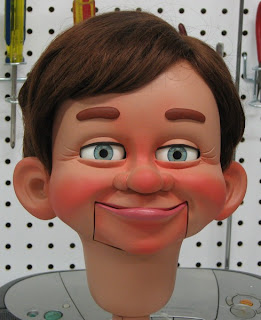And since starting this blog, I have gotten a lot of private response about my posts on blinkers as well. Particularly I've found the most interest in shell winker mechanisms. They take the most precision, and it doesn't take much in the way of errors to have a poor or non-functioning winker mechanism, even after a lot of hard work! How does a professional figure maker handle these challenges? I know when I was first learning, I surely wanted to know.
How does one make a successful mechanism each and every time? Making a living full time as a figure maker for a number of years, and installing quality winker mechanism on a daily or weekly basis, I've had to learn how to do that or starve. (grin) So over time I've developed some sure fire ways to consistently create precise winker mechanics. After giving it much thought, I've decided to share my techniques in a brand new 98 page book specifically on shell winker mechanics.
If you think 98 pages is a lot on just the subject of shell winker mechanics, it is! That's because this is really an in-depth book with numerous, full size, large, clear photos of all the different steps involved. I think you will be amazed at the detail. To keep the price affordable (an all color book full of quality photos can be expensive to publish), I've compiled it into a high-quality PDF E-Book and it is available for instant download. I think you will be pleased with how much information is in this one volume.
So if you've ever struggled with shell winker mechanics before, or have put off trying it because you thought it was too difficult, or you just want more quality information to improve what you are currently doing, this new in-depth book on the subject should help a lot! You can find out more about it on our web site. . .






